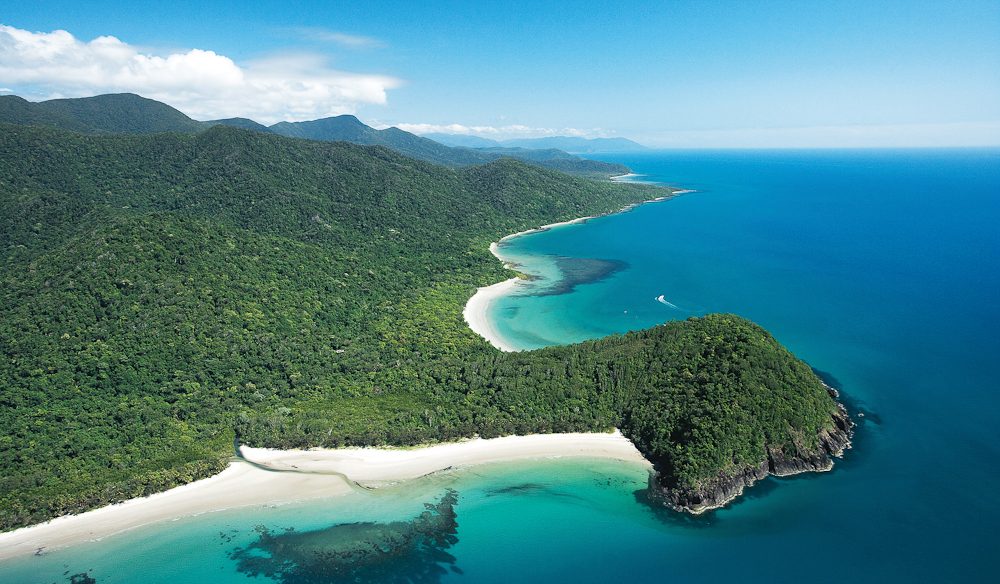16 June 2022
![]() 6 mins Read
6 mins Read

Rainforests, reefs, rich culture, tantalising tropical foods and outback adventures – the Wet Tropics packs it all into one unforgettable package.
It’s the only place in the world where two World Heritage sites exist side by side, from the turquoise paradise of the Great Barrier Reef to the Daintree National Park, a steamy, green wilderness of thunderous waterfalls, strange tropical fruit and wildlife species found nowhere else. Ancient cycads and rare butterflies thrive in the forest, estimated to be 160 million years old; the oldest living tropical rainforest on Earth.
The indigenous Kuku Yalanji have a word for rainforest walk – Marrdja – and you can choose from a variety of boardwalk loops that wind through a dense canopy of ferns, fan palms and fig trees, all the while trilling to a buzzing symphony of tropical birds and frogs. A moonlit night tour of the rainforest offers an altogether different experience of this complex ecosystem.
Take a cruise on the Daintree River, which teems with saltwater crocodiles. Hop in the car and drive to Cape Tribulation – where Lt. James Cook struck the reef in 1770 – looking out for native cassowary birds along the way. Follow a trail into the Mossman Gorge and learn about the Kuku Yalanji people, or join the Bama Way, between Port Douglas and Cooktown, which follows ancient Aboriginal storylines through the rainforest. The adventurous can go white-water rafting on the Tully River, walkers can stride into the Misty Mountain ranges, and wildlife lovers can explore the Mareeba Wetlands, a sanctuary for almost every type of waterbird in Australia.
Wake to a dawn chorus in the wetlands, home to nearly every species of waterbird in Australia. Jabirus, jacanas, cormorants and darters – there are more than 200 species of bird found here. Exploring this 120-square kilometre conservancy by foot, boat, canoe or an open-air safari guarantees spectacular viewing, particularly from the bird-hides at Pandanus Lagoon. The reserve is open April-December, but guests staying at the luxury tented Jabiru Safari Lodge can tour the wetlands outside these hours. See: Mareeba Wetlands; 07 4093 2514.
Cruise the Daintree’s waterways, home to an astonishing diversity of life forms. Stroll beneath the canopies with an expert to learn about ancient, brilliantly coloured plants and maybe even catch sight of a cassowary. These flightless birds, with their vivid blue neck and long, drooping red wattles, are found hiding amid the melaleuca scrub and mangrove forests. Finish with a picnic and a swim at Cooper Creek. See Cooper Creek Wilderness; 07 4098 9126.
Rainforest serenity with a nature-chic vibe… Silky Oaks Lodge in Mossman has all the five-star bells and whistles. Boutique timber cabins are built among the canopy overlooking the rapids of the Mossman River, while candlelit meals are served in a restaurant with 180-degree rainforest views. From your jungle perch, you can watch dragonflies flit about, do some rainforest yoga, read a book in a hammock, or be lulled into a semi-conscious state with a rejuvenating massage at the spa. Phone: 07 4098 1666.
Grumichama and soursop are just some of the exotic fruits that grow in the rainforest. Foodies will get a kick tasting the bizarre selection at the Cape Trib Exotic Fruit Farm, and stopping off to sample the treats at the Daintree Ice Cream Company, which churns out homemade ice-cream made with tropical fruits from their own orchid. Choccy lovers should look out for Daintree Estates chocolate – the only chocolate madefrom Daintree-grown cocoa.
The coastal and rainforest-dwelling Aborigines of this region are wonderful storytellers and hunters. Take a journey into the natural wilderness exploring the Bama Way, which combines the tours and insight of three traditional land custodians from Cairns to Cooktown, focusing on the Kuku Yalanji and Guugu Yimithirr language groups. Learn how to throw a spear on the beach or hunt for mud crabs in the mangrove. Try your hand at ancestral fishing techniques, or follow ancient trails into the rainforest, discovering waterfalls, indigenous medicine and tradition along the way. See The Bama Way; 07 4028 3376.
The best places in the world are always in far-flung locations, like the Bloomfield Lodge, ranked number-one for World’s Best Remote Hotels by Forbes magazine. With water views from every room, and the requisite for any five-star stay – an infinity pool and spa – if you tire of lounging about (though we doubt you will), you can set out on walks through the Daintree, go sport-fishing or cruise up the Bloomfield River. Phone: 07 4035 9166.
Hoot with excitement (mixed with a little terror) on the churning rapids of the Tully, a mighty freshwater river famous for some of the best rafting in the country. After a day tackling the white-knuckle ride, take some time to learn about the local indigenous culture – the Raft and Trek allows an additional day to do the Spirit of the Rainforest walk, a fascinating trek into the verdant canopy, accompanied by a Aboriginal guide from the Jabanbarra Jirrbal tribe. See ingan.com.au; 1300 728 067.
Getting there: Direct flights to Cairns and Townsville – gateways to the Tropical North – run from most Australian cities and regional Queensland centres. The Daintree World Heritage Area is around a two-hour drive from Cairns; Mossman Gorge around 1.5 hours and the Mareeba Wetlands one hour.
Eating there: Main towns Cairns, Townsville and Port Douglas have a thriving café and restaurant culture. In the midst of the rainforest and up to Cape Tribulation, friendly cafés and on-site eateries at lodges offer all kinds of cuisine along with some unique eats (crocodile burgers, anyone?). Don’t miss the rainforest’s tropical fruit, coffee and chocolate.
Staying there: Accommodation options are as diverse as the Daintree’s plant life. Within the World Heritage region are cabins, eco lodges, backpacker hostels, B&Bs and luxurious rainforest spa retreats.
LEAVE YOUR COMMENT